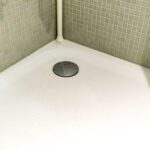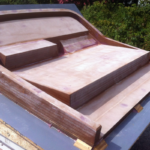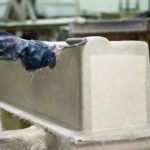Fiberglass boats are a popular choice among boaters due to their durability and low maintenance. However, over time, oxidation can occur on the surface of the fiberglass, resulting in a dull and faded appearance.
Removing oxidation from a fiberglass boat can be a daunting task, but with the right tools and techniques, it can be done effectively and efficiently.
One of the most important steps in removing oxidation from a fiberglass boat is to thoroughly clean the surface. This includes removing any dirt, grime, or other debris that may have accumulated on the surface.
A mild detergent and water solution can be used for this purpose, followed by a thorough rinse with clean water3.

Once the surface is clean, the next step is to assess the level of oxidation present. This can be done by inspecting the surface for any signs of discoloration or fading. Mild oxidation can often be removed with a simple rubbing compound, while more severe cases may require a more aggressive approach.
In the following sections, we will explore some of the most effective methods for removing oxidation from a fiberglass boat.

Understanding Oxidation
Oxidation is a natural process that occurs when the fiberglass boat is exposed to the elements such as sun, rain, and saltwater. Over time, the gelcoat on the surface of the boat begins to break down, causing a chalky, faded appearance. This is known as oxidation.
The oxidation process is accelerated by exposure to UV radiation, which breaks down the chemical bonds in the gelcoat and causes it to lose its shine. Once the gelcoat has oxidized, it becomes porous and begins to absorb water, which can lead to further damage.
To prevent oxidation from occurring, it is important to keep your fiberglass boat clean and protected. Regular cleaning and waxing can help to maintain the shine and prevent oxidation from occurring. However, if your boat has already oxidized, there are several steps you can take to remove it.
One of the most effective methods for removing oxidation is to use a specialized oxidation remover. These products are designed to break down the chalky surface of the gelcoat and restore the shine to the boat.
It is important to follow the manufacturer’s instructions carefully when using these products, as they can be abrasive and may damage the gelcoat if used incorrectly.
In addition to using an oxidation remover, it is also important to protect your boat from further damage. This can be done by applying a high-quality marine wax or polish to the surface of the gelcoat. These products form a protective barrier that helps to prevent oxidation from occurring and keeps your boat looking its best.

Importance of Removing Oxidation
Fiberglass boats are a popular choice for recreational boating due to their durability and strength. However, over time, exposure to the elements can cause oxidation to occur on the surface of the fiberglass.
Oxidation is a chemical process that results in the breakdown of the gel coat, which is the protective layer that seals the fiberglass.
If left untreated, oxidation can cause the fiberglass to become weak and brittle, which can lead to structural damage and even failure. This can compromise the safety of the boat and the passengers on board.
Removing oxidation is essential for maintaining the integrity of the fiberglass and ensuring the longevity of the boat. It not only improves the appearance of the boat but also helps to prevent further damage and costly repairs.
Regular cleaning and maintenance of the boat can help to prevent oxidation from occurring in the first place. However, if oxidation has already set in, it is important to take immediate action to remove it before it causes further damage.
There are various methods for removing oxidation from fiberglass boats, including using specialized cleaning products, sanding, and buffing. It is important to choose the method that is best suited for the specific type and severity of oxidation on the boat.
By taking the necessary steps to remove oxidation from their fiberglass boats, boat owners can ensure the safety and longevity of their vessels, as well as maintain their appearance and value.
Identifying Oxidation on Fiberglass Boat
Visible Signs
One of the most common ways to identify oxidation on a fiberglass boat is by its visible signs. Oxidation appears as a chalky or cloudy appearance on the surface of the boat. It can be seen in areas such as the hull, deck, and topsides. Usually, the affected areas will be lighter in color than the surrounding areas.
Texture Changes
Another way to identify oxidation is by texture changes. The surface of the fiberglass will become rough and pitted, which can be felt by running a hand over the surface. This is due to the breakdown of the gelcoat layer of the fiberglass, which is caused by exposure to the sun and water.
To confirm that the boat has oxidation, one can also perform a simple test. Rub a clean cloth over the surface of the boat, and if the cloth comes away with a white residue, then the boat has oxidation.
It is important to identify and remove oxidation from a fiberglass boat as soon as possible to prevent further damage to the surface. By regularly inspecting the boat and identifying oxidation early on, boat owners can save time and money on repairs in the long run.

Required Tools and Materials
Cleaning Solutions
To remove oxidation from a fiberglass boat, you will need a cleaning solution. There are several options to choose from, including commercially available fiberglass cleaners, household cleaners, and DIY solutions.
Commercially available fiberglass cleaners are formulated specifically for removing oxidation and are often the most effective option.
Household cleaners, such as vinegar or baking soda, can also be effective but may require more elbow grease. DIY solutions, such as a mixture of water and ammonia or water and bleach, can be effective but should be used with caution and only in a well-ventilated area.
Protective Gear
It is important to wear protective gear when removing oxidation from a fiberglass boat. This includes gloves, eye protection, and a mask or respirator. Gloves will protect your hands from the cleaning solution and any debris that may be on the boat.
Eye protection will protect your eyes from splashes of the cleaning solution. A mask or respirator will protect your lungs from any harmful fumes that may be released during the cleaning process.
Manual Tools
In addition to a cleaning solution and protective gear, you will also need some manual tools to remove oxidation from a fiberglass boat. A soft-bristled brush or sponge can be used to scrub the surface of the boat.
A microfiber cloth can be used to wipe away any residue. A buffer or polisher can also be used to restore the shine to the fiberglass. It is important to use a buffer or polisher with caution and to follow the manufacturer’s instructions to avoid damaging the fiberglass.
Overall, with the right tools and materials, removing oxidation from a fiberglass boat can be a straightforward process. By following the proper safety precautions and using the appropriate cleaning solutions and tools, you can restore your boat’s appearance and protect it from further damage.
Step-by-Step Oxidation Removal Process
Preparation
Before starting the oxidation removal process, it is important to prepare the boat. This involves removing any loose debris and washing the boat with soap and water. Once the boat is clean, it should be dried thoroughly to ensure that there is no water left on the surface.
Application of Cleaning Solution
The next step is to apply a cleaning solution to the oxidized areas of the boat. There are many different types of cleaning solutions available on the market, so it is important to choose one that is specifically designed for fiberglass boats.
The cleaning solution should be applied evenly to the oxidized areas using a soft-bristled brush or sponge.
Scrubbing
After applying the cleaning solution, it is important to scrub the oxidized areas of the boat thoroughly. This will help to remove the oxidation and restore the boat’s original shine. It is important to use a soft-bristled brush or sponge to avoid damaging the fiberglass.
Rinsing
Once the oxidized areas have been scrubbed, it is important to rinse the boat thoroughly with clean water. This will help to remove any remaining cleaning solution and ensure that the boat is clean and ready for the next step.
Drying
The final step in the oxidation removal process is to dry the boat thoroughly. This can be done using a soft, clean towel or a chamois. It is important to ensure that the boat is completely dry before storing it, as any remaining moisture can lead to mold and mildew growth.
By following these simple steps, boat owners can effectively remove oxidation from their fiberglass boats and restore them to their original shine.
Post-Oxidation Removal Care
Waxing
After removing the oxidation from a fiberglass boat, it is important to apply a protective wax coating to the surface. This will help prevent future oxidation and keep the boat looking shiny and new.
There are many different types of wax available, but it is important to choose a marine-grade wax that is specifically designed for use on boats. These waxes are formulated to withstand the harsh marine environment and provide long-lasting protection.
To apply the wax, start by washing the boat with a mild soap and water. Once the surface is clean and dry, apply the wax using a soft cloth or applicator pad. Work in small sections, applying the wax in a circular motion. Allow the wax to dry to a haze, then buff it off with a clean, dry cloth.
Regular Maintenance
To keep a fiberglass boat looking its best, regular maintenance is key. This includes washing the boat after each use to remove salt, dirt, and other contaminants that can cause oxidation.
In addition to washing, it is important to inspect the boat regularly for signs of damage or wear. Small cracks or chips in the gelcoat can allow water to penetrate the fiberglass, leading to further damage and oxidation.
To prevent this, make any necessary repairs promptly and keep the boat covered when not in use. A quality boat cover will protect the surface from UV rays, rain, and other environmental factors that can cause damage over time.

Common Mistakes to Avoid
When removing oxidation from a fiberglass boat, there are some common mistakes that should be avoided to prevent damage to the boat’s surface.
Firstly, using abrasive materials such as steel wool or sandpaper can cause scratches on the fiberglass surface, which can lead to further damage. It is recommended to use non-abrasive materials such as a soft cloth or a sponge to avoid any scratches.
Secondly, using harsh chemicals such as bleach or ammonia can cause discoloration or damage to the gel coat. It is recommended to use specialized fiberglass cleaners that are designed to remove oxidation without damaging the surface.
Thirdly, leaving the cleaner on the surface for too long can cause damage to the gel coat. It is important to follow the manufacturer’s instructions and not to leave the cleaner on for longer than recommended.
Lastly, using a pressure washer can also cause damage to the fiberglass surface. It is recommended to use a garden hose with a soft brush attachment to gently clean the surface.
By avoiding these common mistakes, boat owners can effectively remove oxidation from their fiberglass boat without causing any damage to the surface.
Conclusion
Removing oxidation from a fiberglass boat is a necessary task for maintaining its appearance and performance. While it may seem daunting at first, with the right tools and techniques, it can be done easily and effectively.
By using a combination of sanding, polishing, and waxing, boat owners can restore their boats to their original shine. It is important to note that the process may take some time and effort, but the results are worth it.
Boat owners should also be aware of the importance of regular maintenance to prevent oxidation from occurring in the first place. This includes washing and waxing the boat regularly and avoiding exposure to harsh environmental conditions.
Overall, by following the steps outlined in this article, boat owners can successfully remove oxidation from their fiberglass boats and maintain their appearance and performance for years to come.






